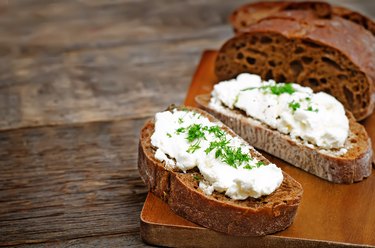
When small, bulging pouches form in the colon, they can become inflamed, causing a condition called diverticulitis. Diet plays an important role in managing a diverticulitis flare-up and can prevent future attacks. Cheese can be a beneficial part of a diverticulitis diet, depending on when you eat it.
Tip
Cheese is a low-fiber food to eat when recovering from a flare-up of diverticulitis. Limit cheese in the diet once the inflammation has resolved to help prevent future attacks.
Video of the Day
A Healthy Colon
The colon makes up the stretch of the intestinal tract between the small intestine and the rectum. Food is mostly digested in the stomach and small intestine. Most of the nutrients have been absorbed by the time the digested material makes its way to the colon.
Video of the Day
The main function of this 4.5-foot stretch of the digestive tract is to absorb water and any remaining nutrients. The interior of a healthy colon is smooth to allow the formation of fecal material and its passage through the rectum and out of the body.
Diverticular Disease and Diet
Over time, usually beginning after age 40, pockets can develop in the wall of the colon. These tiny sacs are called diverticula and often form on the left side of the colon. They tend to be more common in men than women. People who smoke or with obesity may also be more likely to develop diverticula.
Diet is likely the culprit for developing diverticulosis. A diet low in fiber slows down the movement of digested material through the colon, leading to constipation and difficulty with bowel movements. These conditions can result in pouches forming at weakened spots in the colon wall.
People with diverticulosis generally do not have symptoms until the diverticula become inflamed, a condition called diverticulitis. The inflammation occurs due to bacteria in digested material collecting in the pockets and irritating the lining of the colon.
Diverticulosis Diet: High Fiber
Once diverticula form, they become permanent fixtures in the colon. Diet is one of the primary methods for managing diverticulosis to prevent flare-ups of diverticulitis from occurring. Maintaining a healthy weight, quitting smoking, limiting the use of nonsteroidal anti-inflammatory drugs and getting regular exercise can also help prevent diverticulitis.
Eating a high-fiber diet and limiting red meat can prevent inflammation in the colon. Digested material passes more quickly through the gut which decreases the chance of constipation. Insoluble fiber from grains and vegetables produces feces that is easier to pass.
Whole grains such as barley, oats and brown rice are good source of fiber. Legumes, beans, apples, pears and broccoli are also high in fiber. Nuts, such as almonds and pistachios, are another good source of fiber. Cheese does not contain fiber and does not promote swift movement of digested food through the colon.
Symptoms of Diverticulitis
When diverticula become inflamed, people with diverticulitis experience abdominal pain in the portion of the colon that is affected. Abdominal distress in the form of nausea, diarrhea or constipation can also occur. If the tissue becomes infected, people may get fever or chills.
Diverticulitis Diet: Low Fiber
During a diverticulitis attack, you should eat simple, easily digested foods while symptoms persist. Start with clear fluids such as broth, apple juice, tea, flavored gelatin and ice pops. As symptoms improve, gradually add in solid foods that are lower in fiber, so they are easier to digest. Avoid beans, raw vegetables and whole grains during this phase.
Lower-fiber foods to eat with a diverticulitis diet include cooked or canned fruits, cooked vegetables, white bread, white rice, chicken, fish and eggs. Dairy products such as cheese and yogurt have little or no fiber and are safe to eat at this stage. Eat grains that have less than 3 grams of fiber per serving.
The diverticulitis diet should be used short-term while symptoms occur. Once symptoms resolve, gradually begin to increase the fiber content in your diet. Cut back on cheese and continue with a high-fiber diet to help prevent another diverticulitis flare-up.